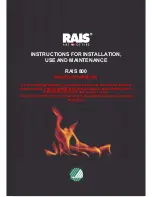
Fig.8
b.
Position in the area to be heated - central
locations are usually best.
c.
Allowance for proper clearances to combustibles.
d.
Obstruction in the ceiling, upper floor or roof, for
example, ducting plumbing, electrical fittings and
wiring, overhead fixed furnishings, etc.
e.
For safety, and to avoid draughts, avoid locations
close to an exit.
CHIMNEY CLEANING
Inspect the chimney connector frequently. Tap the con-
nector with your finger when the pipe is cool. If you hear
a dull echo the pipe may need cleaning. Disassemble the
chimney connector and clean the sections. Replace cor-
roded pipe sections. The fitting of a slip-joint in the stove
pipe makes the dismantling easy for cleaning and inspec-
tion of chimney and stove.
When inspecting a masonry chimney, start at the clean-
out door, normally found in the basement, at the base of
the chimney, or on the outside. If the chimney does not
have a clean-out door it must be inspected and cleaned
by removing stove from chimney.
INSTALLATIONS CLEARANCES
Maintain at least the following clearance to all com-
bustible materials.
From the Front
48”
1220mm
From the Back
16
1/2
”
420mm
From the Sides
25”
635mm
From the Flue Pipe
18”
460mm
Corner
13
1/2
”
345mm
From the Horizontal
connector to the ceiling 18”
460mm
6





























